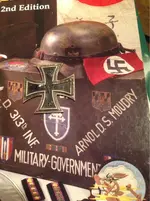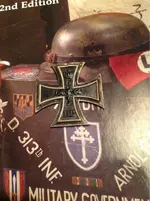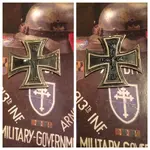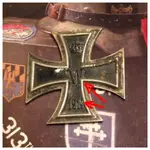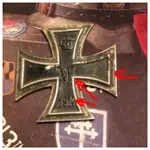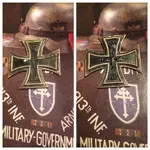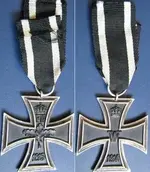This is a totally authentic/original World War One Iron Cross 2nd class. It would hang from one of two different types of ribbon... black base with two white stripes if combatant and white base with two black stripes if non-combatant (doctors, nurses, ambulance drivers, medics, etc.). They are generally of three piece construction, ie: the front and back of the frame (some in silver, some in other metals (later in the war) that are silver plated, and a blackened iron (sometimes brass, popular with naval personnel as no rust issues as with iron). Hence a good way to authenticate is see if a magnet sticks to the iron core (although again brass or other materials were sometimes used), and look at the edge for signs of a seam. Also the cores often loosen up in the frames over time and you can move it slightly if you try. These days $25 is an excellent price. I see relic/damaged, etc., ones on Ebay that go for $50 and up. You can still find deals on these if you keep looking. Best thing to do is look at tons of original examples and fakes. Over time you'll easily see the difference although the fakers keep getting better. You'll learn about fake patinas, etc., and by spotting the fakes in the pictures right off will save yourself tons of money. If not specified in the description ask if it has a seam on the edge of the frame, if the core moves in the frame at all, and if a magnet sticks to the center. A few types were one piece construction, and as I say brass cores, non silver frames, etc., especially as the war wore on and supplies ran short. Most fakes you run into are one piece made of pot metal (similar to lead) and can be easily bent with your fingers and light pressure. They look cheap and are easy to spot. Original will not bend unless using tools to do so.
The Iron cross was first issued in 1813, then in 1870, 1914 and again in 1939. A postwar veteran's version was permitted under German law from 1957 on so are known as the 1957 version or 57er's or 57's. From 1813 to 1914 only four types were issued. A second class like you have which hung by the ribbon. Interestingly the actual medal was only worn when first awarded, and then on dress uniforms on a medal bar... otherwise only the ribbon was worn either on a bar or a buttonhole ribbon. The first class which was a pin or screw back and worn on the area of the tunic on or below the chest pocket on the left side, and the Grand Cross which was much larger and worn on a ribbon at the neck... only issued to General's, Field Marshal's and Royalty for winning major battles/campaigns... very few issued. Lastly there is the Star of the Iron Cross... a breast star with an Iron Cross in the center... again only awarded to those on the top of the heap and exceedingly rare although copies of all can be had from cheap to expensive depending on how well they are constructed.
In WW2 these same classes were awarded, however they created the Knight's Crosses. The Knight's Cross is slightly larger than the 2nd/1st class crosses and worn at the throat on a neck ribbon. Then for further awards you'd receive oakleaves (attached to the top ring of the cross in place of the paper clip type silver hanger) then oakleaves with swords, oakleaves and swords with diamonds (diamonds were placed on the oakleaves and the sword hilts) and one award of the oakleaves, swords and diamonds in gold which went to Oberst (Colonel) Hans Ulrich Rudel of the Luftwaffe (German Air Force). There are also add ons called spanges in the history of the Iron Cross, given as jubilee awards to those winning the 1870 Iron Cross who were still alive in WW1, and for those in WW2 who had been awarded the first or second class cross(es) in WW1 and again in WW2.
There are tons of good forums on the web and more information than you'd probably ever want to know on this subject, not to mention excellent reference books as well. I'd highly recommend a forum called The Gentleman's Military History Club based in England but which has a world wide membership. If you're truly intro'd you can learn much on these, see extremely rare examples covering the history of the Iron Cross and at times can even pick up crosses sold by other members on the forum. If you see any you're intro'd in online or at a store you can generally post and members will confirm if they're authentic or not.
Just so you know, your's "could" be repaired by a competent jeweler. They can make a new ring for the top as well as a new ring for the ribbon, although it helps to have a complete original for them to see the sizes of the rings and how they are placed. But in doing this they'll end up having to polish the frame in the clean up process so you'll lose the patina which collectors value. Replacement ribbons can be had for a few dollars on Ebay, etc. However, most collectors would say leave it as is as the damage is now part of the history of the cross. I think it's a nice piece and one I'd not hesitate to add to my collection if I saw it for sale. Don't know who the seller was but he was absolutely correct in what he told you.
Good luck!
Dan
